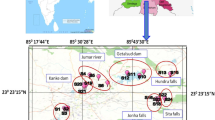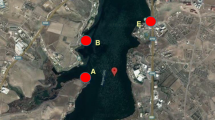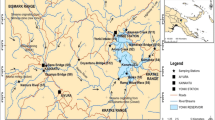Abstract
This study aimed to determine the levels of metals and metalloid (arsenic) in pit lakes from a gold mining site and in their fishes and assess their potential health effect on the local human population, in order to evaluate whether pit lakes can be safely used for aquaculture. Water quality data were collected from two pit lakes, namely West Pit 1 (WP1) and West Pit 2 (WP2), and the Nakambé River (NR) in Burkina Faso. Fish consumption rates in different villages were assessed through a survey. Commonly available fish were sampled from the pit lakes and the NR. Fish from the pit lakes contained higher amounts of metals and metalloid than fish from the river (WP1 ~ WP2 < NR). Of the four species of fish considered, Oreochromis niloticus and Hydrocynus forskahlii had the highest metals and metalloid content and Bagrus bajad and Clarias anguillaris had the lowest. The results indicated that the consumption of the whole fish results in higher metals and metalloid intake than consumption of the fleshy part only. Due to the low fish intake of 5.34 ± 2.60 g/day/adult deduced from the nutritional survey, exposure to metals and metalloid was below referential doses. The highest arsenic intake comes from eating entire O. niloticus (0.058 mg/day/adult) from WP1. Eating O. niloticus and C. anguillaris exposes people to an arsenic intake of 0.01 mg/day/adult. The arsenic contents of H. forskahlii and B. bajad were below the method detection limit.
Graphic abstract



Similar content being viewed by others
References
Abdel-Tawwab, M., Mousa, M., Ahmad, M., & Sakr, S. (2007). The use of calcium pre-exposure as a protective agent against environmental copper toxicity for juvenile Nile tilapia, Oreochromis niloticus (L.). Aquaculture,264, 236–246. https://doi.org/10.1016/j.aquaculture.2006.12.020.
Atobatele, O., & Olutona, G. (2015). Distribution of three non-essential trace metals (Cadmium, Mercury and Lead) in the organs of fish from Aiba Reservoir, Iwo, Nigeria. Toxicology Reports,2, 896–903. https://doi.org/10.1016/j.toxrep.2015.06.003.
Baharom, Z., & Ishak, M. (2015). Determination of heavy metal accumulation in fish species in Galas River, Kelantan and Beranang mining pool, Selangor. Procedia Environmental Sciences,30, 320–325. https://doi.org/10.1016/j.proenv.2015.10.057.
Balistrieri, S. L., & Mebane, A. C. (2014). Predicting the toxicity of metal mixtures. Science of the Total Environment,466–467, 788–799. https://doi.org/10.1016/j.scitotenv.2013.07.034.
Bernhard, J., & Hoffmann, I. (1999). Meat and fish consumption in Burkina Faso with special regard to gender. In Proceedings of the Deutscher Tropentag 1999, Berlin, 1999. Berlin: Humboldt University of Berlin and ATSAF. ftp://ftp.gwdg.de/pub/tropentag/proceedings/1999/referate/STD_A6.pdf. Assessed Jan 2018.
Birungi, Z., Masola, B., Zaranyika, M., & Naigaga, I. (2007). Active biomonitoring of trace heavy metals using fish (Oreochromis niloticus) as bioindicator species. The case of Nakivubo wetland along Lake Victoria. Physics and Chemistry of the Earth,32, 1350–1358. https://doi.org/10.1016/j.pce.2007.07.034.
Bortey-Sam, N., Nakayama, M. M. S., Ikenaka, Y., Akoto, O., Baidoo, E., Yohannes, B. Y., et al. (2015). Human health risks from metals and metalloid via consumption of food animals near gold mines in Tarkwa, Ghana: Estimation of the daily intakes and target hazard quotients (THQs). Ecotoxicology and Environmental Safety,111, 160–167. https://doi.org/10.1016/j.ecoenv.2014.09.008.
Camizuli, E., Monna, F., Scheifler, R., Amiotte-Suchet, P., Losno, R., Beis, P., et al. (2014). Impact of trace metals from past mining on the aquatic ecosystem: A multi-proxy approach in the Morvan (France). Environmental Research,134, 410–419. https://doi.org/10.1016/j.envres.2014.07.008.
CCME. (2008). Canadian water quality guidelines. Ottawa: Canadian Council of Ministers of the Environment.
Cogun, H., & Kargın, F. (2004). Effects of pH on the mortality and accumulation of copper in tissues of Oreochromis niloticus. Chemosphere,55, 277–282. https://doi.org/10.1016/j.chemosphere.2003.10.007.
Compaore, W. F., Dumoulin, A., & Rousseau, D. P. L. (2019). Gold mine impact on soil quality, Youga, Southern Burkina Faso, West Africa. Water, Air, & Soil Pollution, 230(8), 207. https://doi.org/10.1007/s11270-019-4257-z.
Contam, E. F. S. A. (2010). Scientific opinion on lead in food. EFSA Journal,8, 1570. https://doi.org/10.2903/j.efsa.2010.1570.
De Lange, W., Genthe, B., Hill, L., & Oberholste, P. (2018). Towards a rapid assessment protocol for identifying pit lakes worthy of restoration. Journal of Environmental Management,206(206), 949–961. https://doi.org/10.1016/j.jenvman.2017.11.084.
Department of Water Affairs and Forestry. (1996). South African water quality guidelines (2nd ed., Vol. 1, pp. 4–7). Pretoria: Department of Water Affairs and Forestry.
EFSA. (2005). Opinion of the scientific panel on contaminants in the food chain on a request from the european parliament related to the safety assessment of wild and farmed fish. The EFSA Journal,236, 118.
EFSA Contam Panel. (2009). Scientific opinion on arsenic in food. EFSA Journal,7(10), 1351. https://doi.org/10.2903/j.efsa.2009.1351.
EFSA Contam Panel. (2015). Scientific opinion on the risks to public health related to the presence of nickel in food and drinking water. EFSA Journal,13(2), 4002. https://doi.org/10.2903/j.efsa.2015.4002.
Fowe, T., Karambiri, H., Paturel, J.-E., Poussin, J.-C., & Cecchi, P. (2015). Water balance of small reservoirs in the Volta basin: A case study of Boura reservoir in Burkina Faso. Agricultural Water Management,152, 99–109. https://doi.org/10.1016/j.agwat.2015.01.006.
Froese, R., & Pauly, D. (2017). FishBase. (W. W. publication, Editor). Retrieved June 20, 2017, from Fishbase.org: www.fishbase.org.
Kalin, M., Cao, Y., Smith, M., & Olaveson, M. M. (2001). Development of the phytoplankton community in a pit-lake in relation to water quality changes. Water Resources,35(13), 3215–3225.
Kumar, N., Krishnani, K., Kumar, P., Jha, A., Gupta, S., & Singh, N. (2017). Dietary zinc promotes immuno-biochemical plasticity and protects fish against multiple stresses. Fish & Shellfish Immunology,62, 184–194. https://doi.org/10.1016/j.fsi.2017.01.017.
Lévêque, C., Paugy, D., & Teugels, G. (1992). Faune des poissons d’eaux douces et saumâtres d’Afrique de l’Ouest (Collection Faune tropicale no XXVlll ed., Vol. 2). (D. P. Christian Lévêque, Ed.) Paris, France: Musée Royal de l’Afrique Centrale, Tervuren, Belgiques. Editions de I’ORSTOM, Paris, France.
Linde-Arias, A., Inácio, A., De Alburquerque, C., Freire, M., & Moreira, J. (2008). Biomarkers in an invasive fish species, Oreochromis niloticus, to assess the effects of pollution in a highly degraded Brazilian River. Science of the Total Environment,399, 186–192. https://doi.org/10.1016/j.scitotenv.2008.03.028.
Magellan, K., Barral-Fraga, L., Rovira, M., Srean, P., Urrea, G., García-Berthou, E., et al. (2014). Behavioural and physical effects of arsenic exposure in fish are aggravated by aquatic algae. Aquatic Toxicology,156, 116–124. https://doi.org/10.1016/j.aquatox.2014.08.006.
Ouédraogo, O., & Amyot, M. (2013). Mercury, arsenic and selenium concentrations in water and fish from sub-Saharan semi-arid freshwater reservoirs (Burkina Faso). Science of the Total Environment,444, 243–254. https://doi.org/10.1016/j.scitotenv.2012.11.095.
Oyibo, J., Wegwu, M., Uwakwe, A., & Osuoha, J. (2017). Analysis of total petroleum hydrocarbons, polycyclic aromatic hydrocarbons and risk assessment of heavy metals in some selected finfishes at Focados Terminal Delta State. Environmental Nanotechnology, Monitoring and Management. https://doi.org/10.1016/j.enmm.2017.11.002.
Pouil, S., Teyssié, J.-L., Rouleau, C., Fowler, S., Metian, M., Bustamante, P., et al. (2017). Comparative study of trophic transfer of the essential metals Co and Zn in two tropical fish: A radiotracer approach. Journal of Experimental Marine Biology and Ecology,486, 42–51. https://doi.org/10.1016/j.jembe.2016.09.005.
Sako, A., Semdé, S., & Wenmenga, U. (2018). Geochemical evaluation of soil, surface water and groundwater around the Tongon gold mining area, northern Côte d’Ivoire, West Africa. Journal of African Earth Sciences,145, 297–316. https://doi.org/10.1016/j.jafrearsci.2018.05.016.
Shah, Q. A., Kazi, G. T., Arain, B. M., Jamali, K. M., Afridi, I. H., Jalbani, N., et al. (2009). Accumulation of arsenic in different fresh water fish species–potential contribution to high arsenic intakes. Food Chemistry,112, 520–524. https://doi.org/10.1016/j.foodchem.2008.05.095.
Shevenell, L., Connors, A. K., & Henry, D. C. (1999). Controls on pit lake water quality at sixteen open-pit mines in Nevada. Applied Geochemistry,14, 669–687.
Squadrone, S., Burioli, E., Monaco, G., Koya, M. K., Prearo, M., Gennero, S., et al. (2016). Human exposure to metals due to consumption of fish from an artificial lake basin close to an active mining area in Katanga (D.R. Congo). Science of the Total Environment,568, 679–684. https://doi.org/10.1016/j.scitotenv.2016.02.167.
Talab, A., Goher, M., Ghannam, H., & Abdo, M. (2016). Chemical compositions and heavy metal contents of Oreochromis niloticus from the main irrigated canals (rayahs) of Nile Delta. Egyptian Journal of Aquatic Research,42, 23–31. https://doi.org/10.1016/j.ejar.2016.01.003.
Taweel, A., Shuhaimi-Othman, M., & Ahmad, A. (2013). Assessment of heavy metals in tilapia fish (Oreochromis niloticus) from the Langat River and Engineering Lake in Bangi, Malaysia, and evaluation of the health risk from tilapia consumption. Ecotoxicology and Environmental Safety,93, 45–51. https://doi.org/10.1016/j.ecoenv.2013.03.031.
USEPA. (1996). Method 3052, Microwave assisted acid digestion of siliceous and organically based matrices.
USEPA. (2011). Exposure Factors Handbook (Final Report). Edition 2011. Office of Research and Development, National Center for Environmental Assessment. Washington DC, USA, U.S. Environmental Protection Agency. EPA/600/R-09/052F.
WHO. (1996). Trace elements in human nutrition and health. Geneva: Macmillan/Ceuterick - 8000.
WHO. (2011). Guidelines for drinking-water quality (4th ed.). Geneva: WHO Press. ISBN 978-92-4-154815-1.
Woodman, K., Baratoux, L., Somda, A., & Siebenaller, L. (2016). The Youga gold deposit, Burkina Faso. Ore Geology Reviews,78, 631–638. https://doi.org/10.1016/j.oregeorev.2015.11.015.
Acknowledgements
This research was financially supported by the Islamic Development Bank, scholarship division [600026671]. The author thanks the Burkina Mining Company management for permitting the study. Also, greeting goes to the Health Safety and Environment Officers for helping in on-field activities. Special thanks to farmers, households and fisherman of the locality for commitment to this study.
Author information
Authors and Affiliations
Corresponding author
Additional information
Publisher's Note
Springer Nature remains neutral with regard to jurisdictional claims in published maps and institutional affiliations.
Electronic supplementary material
Below is the link to the electronic supplementary material.
Rights and permissions
About this article
Cite this article
Compaore, W.F., Dumoulin, A. & Rousseau, D.P.L. Metals and metalloid in gold mine pit lakes and fish intake risk assessment, Burkina Faso. Environ Geochem Health 42, 563–577 (2020). https://doi.org/10.1007/s10653-019-00390-8
Received:
Accepted:
Published:
Issue Date:
DOI: https://doi.org/10.1007/s10653-019-00390-8




